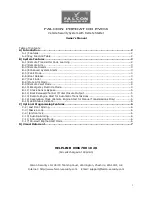
SAFETY INFORMATION
SMOKE ALARM PLACEMENT
Thank you for purchasing a KingShield
Smoke Alarm from GreenBrook
Electrical. This product should be
installed by a competent person and in
accordance with the current IEE Wiring
Regulations. If in doubt, consult a
qualified electrician.
KEEP THESE
INSTRUCTIONS SAFE
FOR FUTURE REFERENCE
ALARM FEATURES
Ionization smoke alarms are generally more
effective at detecting flaming fires which
consume combustible materials
rapidly and spread quickly. Sources of these
fires may include paper burning in a waste
paper or rubbish bin or a grease fire in the
kitchen.
•
AC/DC operated Ionization type smoke
alarm
•
Ionization sensor for fast flaming fires
•
Low battery warning indicator
•
High and stable sensitivity sensor
•
Quick fix mounting bracket and simple
AC connector for simple installation.
•
Fitting and battery tamper-resist feature
•
Inter-connectable with up to
40
units
•
Self test button
•
Alarm and AC power-on LED indicators
•
Smoke alarm will automatically re-set
when smoke clears.
1
. This smoke alarm requires constant
220-240
V AC
50
Hz mains power
supply to operate properly. Backup
9
V
DC battery will offer additional protection
in the event of a power failure. DO
NOT use any other kind of battery
except as specified.
2
. The push-to-test button accurately
tests all smoke alarm functions. DO
NOT use any other test method. Test
the alarm weekly to ensure proper
operation.
3
. This alarm should be installed by
a qualified electrician in accordance
with the current wiring regulations.
4
. This alarm is designed to be used
inside a single family building only. In
multi-family buildings, each individual
living unit should have its own alarm.
DO NOT install in non-residential
buildings or places which house many
people like hotels, motels, dormitories,
hospitals, nursing homes or group
homes. This alarm is not a substitute
for a complete alarm system.
5
. Install an alarm in every room and on
every level of the home. Smoke may
not reach the smoke alarm for many
reasons. For example, if a fire starts in
a remote part of the home, on another
level, in a chimney, wall, roof or on the
other side of a closed door, smoke
may not reach the smoke alarm in
time to alert household members. A
smoke alarm will not promptly detect
a fire except in the area in which it is
installed.
6
. Smoke alarms may not alert every
household member every time. The
alarm sound of the alarm is loud in
order to alert individuals of a potential
danger. However, there may be limiting
circumstances where a household
member may not hear the alarm (i.e.
outdoor or indoor noise, sound sleepers,
the hard of hearing, etc.)
7
. Household members must hear the
alarm’s warning sound and quickly
respond to it, to reduce the risk of
damage, injury or death that may
result from a fire. If a household
member is hard of hearing, install
special smoke alarms with lights or
vibrating devices to alert occupants.
8
. Smoke alarms can only sound their
alarms when they detect smoke.
Smoke alarms detect combustion
particles in the air. They do not sense
heat, flames or gas. This smoke alarm
is designed to give audible warning of
a developing fire. However many fires
are fast-burning, explosive or intentional.
Others are caused by carelessness or
safety hazards. Smoke may not reach
the smoke alarm QUICKLY ENOUGH
to ensure safe escape.
9
. Smoke alarms have limitations. This
smoke alarm is not foolproof and is
not warranted to protect lives or
property from fire. Smoke alarms are
not suitable for insurance. Home
owners and renters should ensure
their lives and property. In addition it
is possible for the smoke alarm to fail
at any time. For this reason, you must
Minimum required smoke alarm locations
Recommended additional smoke alarm locations
Smoke alarms recommended for additional
protection
Two-Story
Residence
Single-Story Residence
test the smoke alarm weekly and re
place every
5
years.
Note:
For best protection, we recommend
that you install a smoke alarm in every
room.
Typical Single-Story Home
Install a smoke alarm on the ceiling or
wall inside each bedroom and in the hallway
outside each separate sleeping area. If a
bedroom area hallway is more than
30
feet long, install a smoke alarm at each
end. If there is a basement, install a
smoke alarm on the basement ceiling at
the bottom of the stairwell.
Typical Multi-Story or Split Level Home
Install a smoke alarm on the ceiling or
wall inside each bedroom and in the
hallway outside each separate sleeping
area. If a bedroom area hallway is more
than
30
feet long, install a smoke alarm
at each end. Also, install a smoke alarm
on the top of a first to second floor stairwell.
IMPORTANT SMOKE ALARM PLACEMENT
AND EXCEPTION INFORMATION
1
. Install a smoke alarm as close to the
center of the ceiling as possible. If this
is not practical, mount no closer than
4
inches from a wall or corner. Also, if
local codes allow, install smoke
alarms on the wall between
4
and
12
inches from the ceiling/wall
intersections.
Installation/Operating
instructions For Smoke Alarm
Model Ref: ASIM (VST-IS
598
IH)
ASIM Smoke Alarm Instructions:Layout 1 1/8/13 11:50 Page 1





















